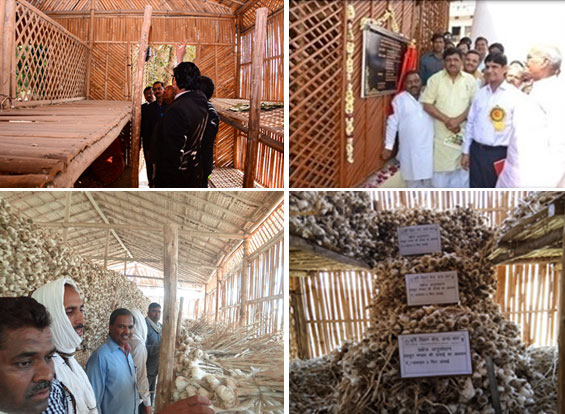सफलतम कहानी
Plantation of Date Palms has changed fortune of farmers in Barmer
Low Cost Storage Structure And Improved Storage Method Enhances Shelf Life Of Garlic
Garlic (Allium sativum L.) is the second most important underground bulb crop after onion grown in irrigated condition and used as a spice or a condiment throughout India. It is also an important foreign exchange earner for India. In Rajasthan, it is largely grown in Baran, Jhalawar, Kota, Bundi (Haroti region), Chittorgarh, Jodhpur and Pratapgarh districts especially along the irrigated tracts. Haroti region is considered as the garlic bowl of Rajasthan, producing 90% of the crop. During the year 2018-19, Garlic has been cultivated on 1.32 lakh ha area in Rajasthan and with average productivity of 5.4 metric tonnes per ha 7.18 lakh metric tonnes production is estimated. It is grown in soybean-garlic based cropping system since two decades. The production made in these areas has its fragrance familiarity in many gulf countries too. Garlic forms principal ingredients in spicy foods especially non-vegetarian cuisines. Spicy preparations based on meat, instant food, chips, papad, etc. draw heavily on garlic or its derivatives. Nowadays pastes, powder, flakes, garlic capsules are catching fast in the market.
Low cost thatched roof bamboo garlic storage structure
Garlic is stored as a whole intact plant in room and required large space. The farmers of this region faced the problem of rotting and pumping of bulb stored in room. Market price at the time of harvesting is low and storage of garlic bulb at room temperature causes losses up to 43-50%. In Baran district losses of garlic during storage in room is found to be 34.5%. However, a low cost thatched roof bamboo garlic storage structure costing only Rs. 1.0 lakh was developed at Krishi Vigyan Kendra, Anta, Baran under the RKVY Funded ‘Garlic Excellence Centre’ project. The size of structure was 15’ (w) X 30’ (l) X 12’ (h) and made from bamboo sticks with cemented floor. The storage capacity of structure is 10 tons of garlic. The structure was inaugurated by Honorable Minister of Agriculture, Government of Rajasthan on 4th March 2017. This storage structure becomes one of the model units for the garlic growers in local area. The storage was used for storing the produce (bulbs to be used as seeds) of nearby farmers with minimal charges @ Rs. 50 per bag of 40kg and earned Rs. 20,000 within six months.
Standardization of garlic heap in storage
Garlic is stored in storage as whole plant and requires ventilation to prolong shelf life. Height of garlic heap is important factor affecting the shelf life of garlic bulb. Storage of whole garlic plants up to 3 feet height was found most suitable to decrease the rotting (3.40%) and weight losses of bulb (4.04%) in low cost garlic storage structure due to proper ventilation enabling circulation of fresh air. The highest weight loss (22.24%) has been found in farmer storage practices. The partition of garlic heaps up to 3.0 feet height is the most effective method of storage in storage structure for longer shelf life of garlic.
Table-1 : Effect of height of heap of garlic plants on bulb rotting and weight loss during storage in low cost storage structure
| Garlic heap height (Feet) | Bulb rotted (%) | Weight of whole plants (g) | Weight of whole plants after 200 DAS* (g) | Weight loss (%) |
|---|---|---|---|---|
| Farmers practice (7-8) | 34.5 | 33.45 | 26.01 | 22.24 |
| 3 | 3.4 | 41.57 | 39.89 | 4.04 |
| 4 | 5.3 | 38.21 | 35.76 | 6.41 |
| 5 | 7.2 | 36.34 | 31.21 | 14.12 |
*Days after storage
Output
(Source : KVK Anta-Baran, Rajasthan 325 202 and ICAR-Agricultural Technology Application Research Institute, Zone-II, Jodhpur, Rajasthan 342 005)
- Fig 1 : Low cost garlic storage structure developed at KVK Anta-Baran is visited by Dr. Rajguru Nagar, Director, DOGR, Pune
- Fig 2 : Low cost garlic storage structure inaugurated by Hon’ble Minister of Agriculture, GoR
- Fig 3 : A view of garlic storage in the low cost storage structure
- Fig 4 : Storage of garlic in heaps of different heights in low cost storage structure

श्री जीवनराम पटेल - अग्रणी किसान की सफलतम कहानी
(कृषि विज्ञान केन्द्र, डूंगरपुर)

श्री जीवनराम, गाँव बुजाड़ा, तहसील बिछवारा, जिला डूंगरपुर, राजस्थान के मध्यमवर्गीय किसान है। इनकी शिक्षा बारहवीं तक है तथा इनके पास स्वयं की 4 हैक्टेयर खेती योग्य भूमि है। परिवार की आर्थिक स्थिति कमजोर होने के कारण ये बारहवीं के बाद नहीं पढ़ सके और परिवार की आवश्यकताओं को पूरा करने के लिए ये कुवेत चले गये। वहाँ पर भी ये सफल नहीं हो सके और वापस आकर अपने पिता के साथ मिलकर खेती करने लगे। इनके पास खेती योग्य पर्याप्त भूमि और जल की सुविधा होते हुए भी खेती की नवीन तकनीकियों की जानकारी न होने के कारण अधिक लाभ नहीं कमा पा रहे थे। पूरे परिवार द्वारा स्थानीय तरीके को अपनाकर खेती में लगे होने के कारण परिवार अपनी आर्थिक जरूरतों को भी पूरा नहीं कर पा रहा था। वे मक्का, चावल, गेहूँ, मूंग, उड़द, चना और गन्ने की फसलों की स्थानीय किस्मों की बुवाई अपने खेत पर करते थे। उनके पास 2 भैंसे भी थी जो कि बहुत ही कम दूध देती थी। पाँच वर्ष पूर्व उन्होंने 7 संकर प्रजाति की गायें और 3 मुर्रा प्रजाति की भैंसे नाबार्ड की सहायता से बैंक आँफ बड़ौदा, बिछवारा, जिला डूंगरपुर से 25 प्रतिशत छूट पर ऋण लेकर डेयरी प्रांरभ की, परन्तु उचित कौशल के अभाव में वे इससे ज्यादा लाभ नहीं कमा सके। इस कारण वे इस क्षेत्र में प्रशिक्षण लेने के लिए संस्थानों की खोज करने लगे जिससे की वे अच्छी आय प्राप्त कर सके।

चार वर्ष पूर्व 2013 में श्री जीवन पटेल ने कृषि विज्ञान केन्द्र, डुंगरपुर के संस्थागत प्रशिक्षण में भाग लेकर कृषि विज्ञान केन्द्र-डूंगरपुर के वैज्ञानिकों से संपर्क किया। उन्होंने कृषि विज्ञान केन्द्र के वैज्ञानिकों द्वारा फसलों, सब्जियों, प्रसंस्करण और मूल्य सवंर्धन, पशुपालन, समन्वित कीट प्रबंधन एवं मुर्गीपालन पर आयोजित विभिन्न संस्थागत एवं गैर-संस्थागत प्रशिक्षण कार्यक्रमों और किसान संगोष्ठियों, प्रक्षेत्र दिवस, प्रक्षेत्र भ्रमण, किसान मेलों और पशु उपचार शिविरों में भाग लिया। कृषि विज्ञान केन्द्र के मार्गदर्शन में उन्होंने फसलों और सब्जियों की उन्नत किस्मों से खेती आरंभ की तथा उन्होंने अपने खेत पर वर्मी-कम्पोस्ट, अजोला इकाई और प्रतापधन किस्म का मुर्गीपालन इकाई की स्थापना के साथ ही मक्का, सोयाबीन, मूंग, मिर्ची, भिण्डी आदि पर प्रथम पंक्ति प्रदर्शन भी आयोजित किये। वे कृषि विज्ञान केन्द्र के नियमित संपर्क में रहने लगे तथा समन्वित कृषि तकनीकों की जानकारी प्राप्त करने के लिए कृषि विज्ञान केन्द्र द्धारा संचालित व्हाॅट्सएप के भी सदस्य है।

वर्तमान में नवीन तकनीकियों को अपनाने और अपने प्रयासों, मेहनत और समय पर कृषि विज्ञान केन्द्र और अन्य विभागों की तकनीकी सलाह के कारण उनकी आय तथा जीवन स्तर में भी वृद्धि हुई।
श्री जीवन पटेल की सफलता को देखकर आस-पास के गाँवों में (करौली, गड़माला, हाथौड़, पाडली, माँड़ा और बिछीवारा) किसान भी उनसे लाभकारी कृषि प्रणालियों और उन्नत पशुपालन की तकनीकों की जानकारी के लिए उनसे संपर्क कर रहे है।
तालिका : समन्वित कृषि प्रणाली के विभिन्न घटकों से श्री जीवनराम पटेल की औसत वार्षिक आय
| क्र.स. | विवरण | औसतन वार्षिक आय (लाख में) |
|---|---|---|
| 1 | फसल उत्पादन | रू 2.00 |
| 2 | सब्जी उत्पादन | रू 0.60 |
| 3 | दुग्ध उत्पादन | रू 3.00 |
| 4 | मुर्गीपालन | रू 2.00 |
| 5 | वर्मीकम्पोस्ट | रू 0.50 |
| कुल आय | रू 8.10 |
उन्नत तकनीकियाँ अपनाने से पूर्व श्री जीवन पटेल के परिवार की आर्थिक स्थिति अच्छी नहीं थी। परन्तु वर्तमान में नवीन तकनीकियाँ अपनाने के बाद वे न केवल अपने परिवार की जरूरतों को पूरा कर पा रहे है बल्कि अपने बच्चों को अच्छी शिक्षा भी दे रहे है तथा उनके खरीदने की क्षमता में वृद्वि होने के कारण उन्होंने फ्रिज, एलसीडी टीवी, स्मार्ट फोन, मोटरसाइकिल, घास काटने की मशीन आदि सम्पंतिया भी खरीदी है। वर्तमान में वे बिछवारा, डूंगरपुर, राजस्थान में प्रगतिशील किसान के रूप मंे जाने जाते है तथा अन्य किसान उनका अनुसरण भी कर रहे है।
श्री जीवनराम पटेल भाकृअनुप-कृषि तकनीकी अनुप्रयोग संस्थान, जोधपुर की परियोजना में एक अग्रणी किसान के रूप में कार्य कर रहे है एवं नवीनतम तकनीकों को साथी किसानों को सिखा कर कृषि प्रसार में मदद कर रहे है। वह कृषि विज्ञान केन्द्र में आयोजित किये गये प्रशिक्षणों में किसानों के लिए एक मास्टर ट्रेनर की भूमिका भी अदा कर कर रहे हैै।



